#chicago great western
Text

CGW #192, Maywood IL June 1968
Chicago Great Western #192 is close to the end of its run as it rolls through Maywood Illinois on a hot summer day in 1968. The headlight of the Chicago Local following closely behind can be seen in the corner of the frame under the IHB bridge.
45 notes
·
View notes
Photo

Chicago Great Western 349 at Kansas City, KS
February 10, 1946
22 notes
·
View notes
Text

Tyrone Power and Alice Faye in In Old Chicago 1938 🔥
#old hollywood#beauty#romantic drama#1930s cinema#historical drama#western#disaster film#tyrone power#alice faye#don ameche#tom brown#alice brady#great chicago fire
25 notes
·
View notes
Text

Here’s an updated version of my profile picture of me made greatly by @grantgfan and @hunty627. Since I have Procreate, I thought I’d expand and add different shirts and caps (and even shoes) to myself in these pictures. But the one above is the first and original profile and can be used from time to time by myself, Grant and Hunter. And this setup has a shirt that’s green on the top half and has the New York Central logo on it, and the bottom half is red and has the Pennsylvania Railroad logo on it. This shirt’s setup is a nod to the fact that NYC and PRR were fierce arch rivals during their day (before public betrayal, ICC villainy and interference, and mergers happened) over the routes between New York City and Chicago. Not to mention NYC was often dubbed the “Green Team” and PRR was dubbed the “Red Team”. As for the cap, it’s light blue’n’blue and has the Union Pacific logo, and that’s a reference to the fact that UP is the only surviving ancient American railroad.
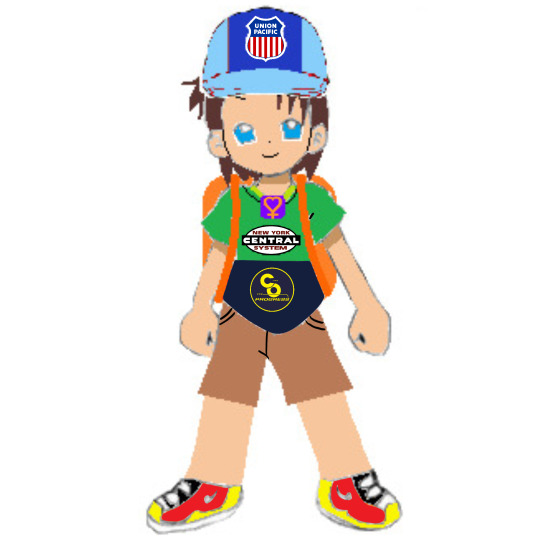
Here’s the first new profile, and this second shirt has its top half green with the New York Central logo on it, and bottom half navy blue and has the Chesapeake and Ohio logo on it. This symbolizes the fact that during the age of steam on the railroads, the New York Central got the coal for its steam locomotives from the Chesapeake and Ohio.
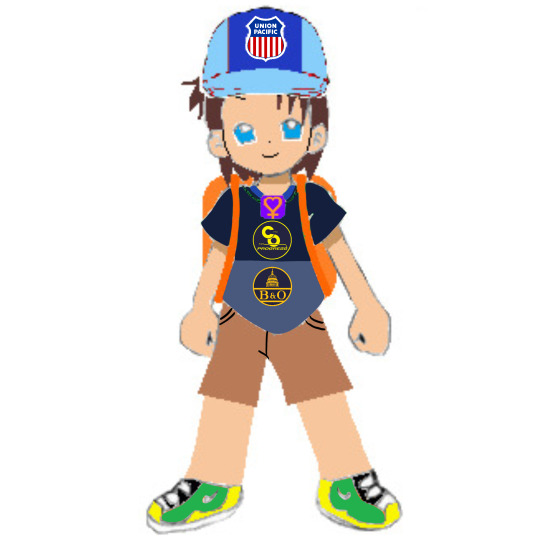
Here’s the second setup in this group of setups. In this one, I have a shirt that’s navy blue on the top half and has the Chesapeake and Ohio logo, and the bottom is a lighter blue and has the Baltimore and Ohio logo. This set is a reference to the fact that C&O and B&O had a rivalry in terms of transporting people and goods across the Application Mountains.

Here’s the third setup in this group of setups. Here, I have an orange’n’red cap with the Milwaukee Road logo on it. The shirt here has a yellow’n’green top half with the Chicago and Northwestern logo on it, and the bottom half is white’n’red and has the Burlington Route logo on it. This setup is a reference to the fact that during the golden days of American railroading (before public betrayal, ICC villainy and interference, and mergers), these three railroads had a super tense rivalry with each other over the railroad routes between Chicago and Twin Cities (Minneapolis and St. Paul), with Milwaukee Road’s Twin Cities Hiawatha, Chicago and Northwestern’s Twin Cities 400 and Burlington Route’s Twin Cities Zephyr all racing against each other from Chicago to Twin Cities, and from Twin Cities to Chicago.

Here’s the fourth and final setup for this group of setups. Here, I have a red’n’white cap with the Burlington Route logo on. And the shirt here has its top half with the two shades of green of Northern Pacific and the Northern Pacific logo on it, and the bottom half of the shirt has orange and brown of Great Northern and has the Great Northern logo on it. This setup is a reference to the formation of Burlington Northern, which was formed when these three railroads merged on March 2nd, 1970.
And that’s all the setups for this batch. More are on the way, I just gotta think about what other colors and railroad logos to add and in which specific setup to serve as a reference to historical facts regarding the specific railroads.
#my oc character#my oc art#union pacific#new york central#pennsylvania railroad#chesapeake & ohio#baltimore & ohio#milwaukee road#chicago & north western#burlington route#northern pacific#great northern#the genie team#genie team
4 notes
·
View notes
Link
I posted a linked article yesterday about the same topic as this one: diverting Mississippi River water to points west. That article, as does this one, lists the practical impediments to any project of that scope. But that article misses one important point as does this article from the Desert Sun.
The volume flow of the Mississippi River in its middle and lower ranges (or from Illinois to the Gulf of Mexico) is enhanced by water usage in the Chicago area. Water is withdrawn from Lake Michigan, in volumes consistent with the agreement among the US states and territories of Canada that share shores with the Great Lakes. The water is used in the Chicago area, then sent to one of several waste treatment plants, then eventually discharged into the Illinois River which flows into the Mississippi River. That flow is the reverse of the historical flows of water in the Great Lakes Basin. Before interference with humans, water used in the Chicago area generally came from Lake Michigan and was returned to Lake Michigan. Now, Great Lakes Basin water in amounts equivalent to the discharge from the Metropolitan Water Reclamation District of Greater Chicago eventually lands in the Mississippi River. So, in a way, Chicago causes the Mississippi River flow to be larger than it naturally would be.
The Reclamation District treats an average of 1.3 billion gallons of water each day, and its total water treatment capacity is over 2 billion gallons per day.
So how about looking at the transfer of water from the Mississippi River not as a transfer from the Mississippi River, in its natural state, or the transfer of excess water from the Great Lakes, which it is not, but a transfer of the Lake Michigan water that is currently flowing into the Mississippi because of the Chicago area usage and reclamation structure. 1.3 billion gallons of water each day available to drought areas in the Great Plains states or the western US seems like a lot to me, but I totally fail to grasp water volumes. According to Dr. Google, the Mississippi River discharges 16,792 cubic meters (593,003 cubic feet) of water per second into the Gulf of Mexico. How much of those cubic meters are attributable to the Chicago area? Would that help the drought?
#western US drought#Mississippi River#Great Lakes#Metropolitan Water Reclamation District of Greater Chicago#water
9 notes
·
View notes
Text
American Auto Trail-Great River Road (Winona MN to Galesville WI)
American Auto Trail-Great River Road (Winona MN to Galesville WI)
https://youtu.be/X4-bIQo6WwU
This travel route begins in Winona, MN, before crossing the Mississippi River into Wisconsin and following a section of the Great River Road to Galesville.
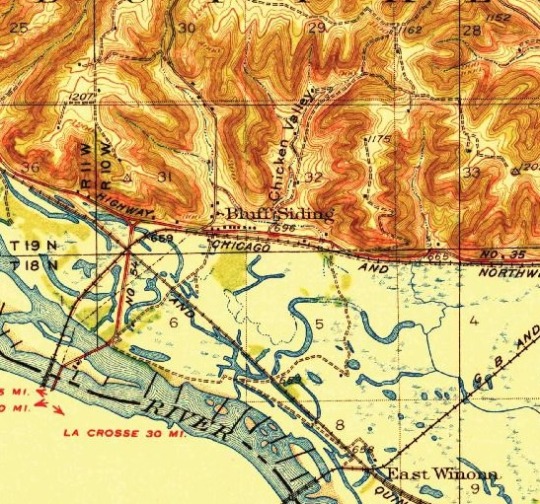
View On WordPress
#4K#Auto trail#Chicago & Northwestern#driving video#Galesville#Great River Road#Green Bay#minnesota#railroad#road travel#slow travel#Trempealeau#western#Winona#wisconsin
0 notes
Text
The great fault of the global left is not that it supports Hamas. For how could Western left-wing movements or left-inclining charities or academic bodies truly support Hamas if they were serious about their politics?
No one outside the most reactionary quarters of Islam shares Hamas’s aim of forcing the peoples of the world to accept “the sovereignty of Islam” or face “carnage, displacement and terror” if they refuse. You cannot be a progressive and campaign for a state that executes gay men. An American left, which includes in its ranks the Queers for Palestine campaign group, cannot seriously endorse lethal homophobia in its own country. They will turn a blind eye in Palestine, as we shall see, but not in New York or Chicago.
Finally, no left organisation proudly honours the Protocols of the Elders of Zion and the fascist tradition that Hamas embraces with such sinister gusto, although in a sign of a decay that has been building on the left for more than a generation, many will promulgate left-wing conspiracy theories which are as insane as their fascist counterparts.
No, the problem with the global left is that it is not serious about politics. It “fellow travels” with radical Islam rather than supports it. The concept of “fellow travelling,” with its suggestions of tourism, dilettantism, and privilege, is well worth reviving. The phrase comes from the Bolsheviks. After the Russian Revolution of 1917 they looked with appreciation on Westerners who supported them without ever endorsing communism. Artists, writers, and academics who were disgusted with the West, often for good reason, I should add, were quite happy to justify Soviet communism and cover up its crimes without ever becoming communists themselves.
Leon Trotsky put it best when he said of fellow travellers that the question was always “how far would they go”? As long as they did not have live under the control of communists in the 1920s or the control of Islamists in the 2020s, the answer appears to be: a very long way indeed
W.H. Auden said, as he looked back with some contempt on his fellow travelling past, if Britain or the United States or any country he and his friends knew were taken over by a “successful communist revolution with the same phenomena of terror, purges, censorship etc., we would have screamed our heads off”. But as communism happened in backward Russia “a semi-barbarous country which had experienced neither the Renaissance nor the Enlightenment”, they could ignore its crimes in the interests of seeing the capitalist enemy defeated.
You see the same pattern of lies and indulgence in the case of Hamas. Journalists have produced a multitude of examples of fellow travelling since 7 October but let one meeting of the Oakland City Council in the Bay area of San Francisco speak for them all.
A council member wanted the council to pass a motion that condemned the killings and hostage-taking by Hamas, who, in case we forget, prompted the war that has devastated Gaza, by massacring Israeli civilians. The motion got nowhere
According to one speaker Hamas did not massacre anyone, a modern variant of Holocaust denial that is becoming endemic. “There have not been beheadings of babies and rapings,” a woman said at the meeting. “Israel murdered their own people on October 7.” Another woman said that calling Hamas a terrorist organization is “ridiculous, racist and plays into the genocidal propaganda that is flooding our media.” Hamas was the “armed wing of the unified Palestinian resistance” , said a third who clearly had no knowledge of the civil war between Hamas and Fatah.
“To condemn Hamas was very anti-Arab racist” cried a fourth. The meeting returned to modern Holocaust denial as a new speaker said the Israeli Defence Forces had murdered their own people and it was “bald propaganda” to suggest otherwise. A man intervened to shout that “to hear them complain about Hamas violence is like listening to a wifebeater complain when his wife finally stands up and fights back”.
Anyone who contradicted him was a “white supremacist.”
Of course they were.
Now if theocrats were to establish an Islamist tyranny in the Bay area, I am sure every single speaker would scream their heads off, as Auden predicted. They can turn into fellow travellers as there is no more of a prospect of theocracy threatening them than there was of communism threatening readers of the left-wing press in the UK and US in the 1930s.
A serious left would have plenty to complain about. Consider the Israeli position after the breakdown of the ceasefire. The Israeli state is led by Benjamin Netanyahu, a catastrophe of a prime minister, who left his people exposed to the worst massacre of Jews since the Holocaust. His war aims are contradictory: you cannot both wipe out Hamas and free the hostages.
Worst of all, the Israeli defence forces are to move to the southern Gaza strip where two million Palestinians are crammed. Just war doctrine holds that a military action must have a reasonable chance of success if the suffering is to be permitted. How, reasonably, can the Israeli army expect to find guerilla fighters hiding in a terrified population? According to leaks in the Israeli media, Anthony Blinken, the US Secretary of state, was warning the Israeli government that, “You can’t operate in southern Gaza in the way you did in the north. There are two million Palestinians there.” But he was ignored. A radical movement worth having would surely be putting pressure on the Biden administration to force Israel to listen to its concerns.
The radical movement we have will not engage in practical politics because compromise is anathema to it. Any honest account of the war would have to admit that Israel has the right to defend itself against attack. It is just that the military position it finds itself in now may well make its war aims impossible and therefore immoral.
You can see why practical politics has no appeal. Where is the violent satisfaction in sober analysis, the drama in compromise? Where is the Manichean distinction between the absolute good of the Palestinians and the pure evil of Israel?
Meanwhile, ever since the Israeli victory in the Six Day War of 1967, you have been able to say that Jewish settler sites on the West Bank were placed there deliberately to make a peace settlement impossible, and ensure that Israel controlled all the territory from “the river to the sea” forever.
A serious left might try to revive a two-state solution by building an international consensus that the settlements must go. Once again, however, that is too tame an aim. For the fellow traveller watching Palestine from a safe distance, satisfaction comes only by embracing Hamas’s call for the destruction of Israel. Some progressives try to dress up the urge to destroy by pretending that Jews and Palestinians will go on to live together in some happy-clappy, multi-ethnic and multi-confessional state. But most must know they are advocating a war to the death. What makes their position so disreputable is that, if they thought about it calmly, they would know it would be a war that only Israel could win. It is the Israelis who have the nuclear weapons, after all.
The worst of the global left is dilettantish. It advocates a maximalist position which has a minimal chance of success - just for the thrill of it. David Caute, a historian of fellow travelling with Stalin and communism said that the endorsement of communism by fellow travelling intellectuals in the West “deepened the despair” of Soviet intellectuals. “In their darkest hours they heard themselves condemned by their own kind”.
The 2020s are not the 1930s. I am sure that, if I were a Palestinian in Gaza, my sole concern would be the removal of Israeli forces that threatened me and my family. I would either not care about demonstrations in the West or I would receive some comfort from the knowledge that people all over the world were protesting on my behalf.
Nevertheless, a kind of betrayal is still at work. By inflaming and amplifying the worst elements in Palestine the global left is giving comfort to the worst elements in Israel, which are equally determined to make a compromise impossible.
The New Statesman made that point well when it ran a piece by Celeste Marcus. She came from the Zionist far right, and was taught doctrines that dehumanised Palestinians. She grew up and grew away from the prejudices of her childhood and became a liberal. But after she moved into her new world, she “recognised immediately that progressive leftists feel about Israelis the way radical Zionists feel about Palestinians: these are not real people.”
The result is that for all its power on the streets and in academia the global left is almost an irrelevance.
“To influence Israel,” she writes, “one must be willing to recognise it. Since leftist leaders cannot bother to do this, they cannot be of real use to Palestinians. This is a betrayal of their own cause.”
The dilettantism of fellow travelling always ends in betrayal and denial for the reason Auden gave: terror is always more tolerable when it happens far, far away.
404 notes
·
View notes
Text
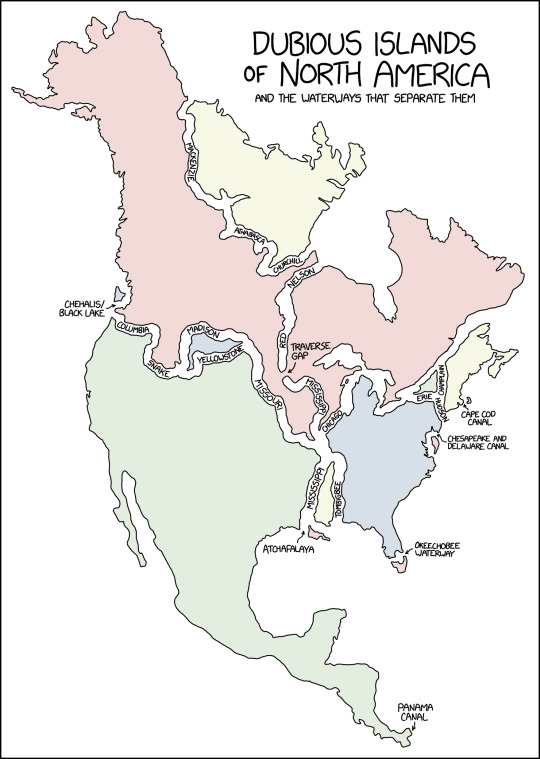
Running for office in Minnesota on the single-issue platform 'dig a permanent channel through the Traverse Gap because it will make this map more satisfying.'
Dubious Islands [Explained]
Transcript Under the Cut
[Title:] Dubious Islands of North America
[Subtitle:] And the waterways that separate them
[A map of mainland North America, down to the Panama isthmus. It is internally separated by various waterways, given labels or otherwise.]
[Separating land approximating Nunavut (with some Northern Territories) from neighbouring Canada:]
Mackenzie Athabasca Churchill
[Comprising the much of the remainder of Canada, much of the northern United States (including Alaska), additionally separated by:]
Columbia Snake Madison Missouri Chicago
[Unlabelled, some of the Great Lakes and the channel past Quebec] [An incursive gap near the central point, from the north:] Nelson Red
[An internal label, with arrow:] Traverse Gap
[An incursive gap near the central point, from the south:] Mississippi
[A separate fragment of land south of the Madison, in the western half of the land-mass, bordered to its south by:] Yellowstone
[A small fragment off the southen part of the western edge, an arrow and a label:] Chehalis/Black Lake
[Nova Scotia, New Brunswick and parts of the adjacent US, disconnected by:] Champlain Hudson
[Label with an arrow on the east coast:] Cape Cod Canal
[A small triangle of territory, further isolated by:] Erie
[Most of the Eastern Seaboard of the US, additionally divided off by:] Tombigbee
[Fragment of land shorn from the northern part of the eastern edge, label with arrow:] Chesapeake and Delaware Canal
[Fragment of land shorn from the tip of Florida, label with arrow:] Okeechobee Waterway
[Strip of land west of the Tombigbee, bounded also to its west by:] Mississippi
[Fragment of land immediately to its south, with a nearby label and arrow:] Atchafalaya
[The remainder of the continent; comprising much of the US, all of Mexico and various central American territories, with a final tip of the eastwards-bending isthmus:] Panama Canal
549 notes
·
View notes
Text
Pink is for Boys
"Pink or Blue? Which is intended for boys and which for girls? This question comes from one of our readers this month, and the discussion may be of interest to others. There has been a great diversity of opinion on this subject, but the generally accepted rule is pink for the boy and blue for the girl. The reason is that pink, being a more decided and stronger color, is more suitable for the boy, while blue, which is more delicate and dainty, is prettier for the girl." ~ The Infants' Department, June 1918


[Left: The Blue Boy, oil on canvas, c. 1770, by Thomas Gainsborough.
Right: The Pink Boy, oil on canvas, c. 1782, by Thomas Gainsborough.]
Pink is for girls and blue is for boys. But it hasn't always been this way. Colour coding infants as a way of denoting gender was popular in 20th century America. The problem? Pink and blue? Which is for boys and which is for girls?
In 1927 TIME Magazine asked ten of the "leading stores that sell baby equipment" which colour was for which gender. Four stores responded pink for girls and blue for boys; Macy's (Manhattan), Franklin Simon (Manhattan), Wanamaker's (Philadelphia) and Bullock's (Los Angeles). Five stores responded pink for boys and blue for girls; Best's (Manhattan), Marshall Field's (Chicago), Filene's (Boston), Maison Blanche (New Orleans) and The White House (San Francisco). Curiously Halle's (Cleveland) responded that pink was for both boys and girls.
This debate would continue and it wasn't until mid-20th century that pink for girls and blue for boys became firmly cemented in western culture.
However the idea of colour coding infants dates back to the 19th century. According to La cour de Hollande sous le règne de Louis Bonaparte in 1808 in Holland pink was used to announce the birth of a girl and blue a boy. In March 1856 Peterson's Magazine (Philadelphia, USA) advises that the ribbon on a christening cap should be blue for a boy and pink for a girl. On the 23rd of July 1893 the New York Times writes that for baby clothes it's "pink for a boy and blue for a girl!"

[The Oddie Children, oil on canvas, c. 1789, by William Beechey, via North Carolina Museum of Art.]
During the latter half of the 18th century one of the most popular outfits for young children, regardless of gender, was a white dress with a coloured sash tied around the waist. Pink and blue being the most popular colours, although other colours were worn as well. It would be tempting to assume that the colour of the sash indicated gender but there isn't clear evidence that this was the case. The Oddie Children (above) depicts Sarah, Henry, Catherine, and Jane Oddie. The three girls are all wearing white dresses; two with a blue sash one with a pink sash. We also see Henry Russell (bellow left) wearing a blue sash and Prince William (bellow right) wearing a pink sash.
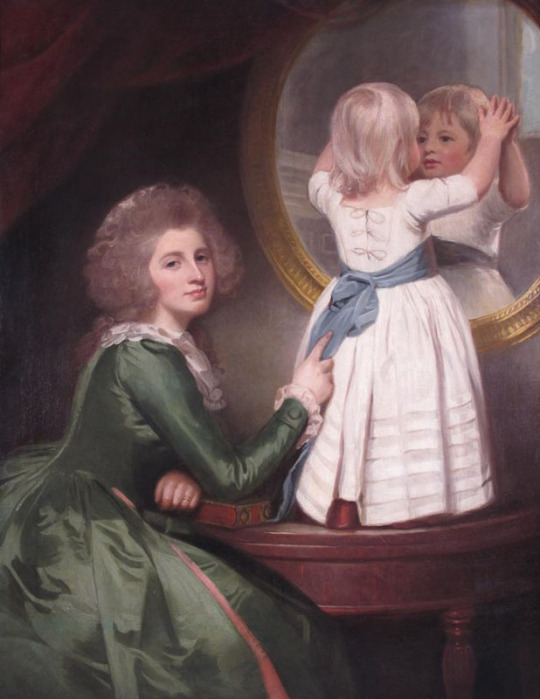
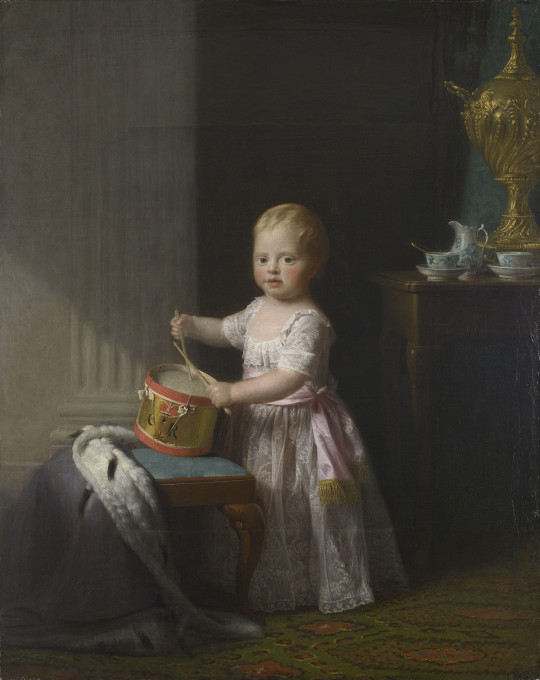
[Left: Anne Barbara Russell née Whitworth with her son Sir Henry Russell, oil on canvas, c. 1786, by George Romney, via Woolley & Wallis.
Right: Prince William, oil on canvas, c. 1767, by Allan Ramsay, via the Royal Collection Trust.]
Pink was just one of the many colours popular in 18th century English womenswear and seems to have stayed popular throughout the century. On the 3rd of January 1712 The Spectator published an article in which a man recalls seeing "a little Cluster of Women sitting together in the prettiest coloured Hoods that I ever saw. One of them was Blew, another Yellow, and another Philomot; the fourth was of a Pink Colour, and the fifth of a pale Green". On the 1st of May 1736 the Read's Weekly Journal, or British Gazetteer reports that the ladies attending the royal wedding wore gowns of "Gold stuffs, or rich Silks with Gold or Silver Flowers, or Pink or White Silks, with either Gold or Silver Netts or Trimmings;" shoes either "Pink, White or Green Silk, with Gold or Silver Lace and braid all over." On the 24th of May 1785 Charles Storer writes to Abigail Adams advising that fashionable colours in English court dress are "pink, lilac, and blue" such "as is worn at Versailles".
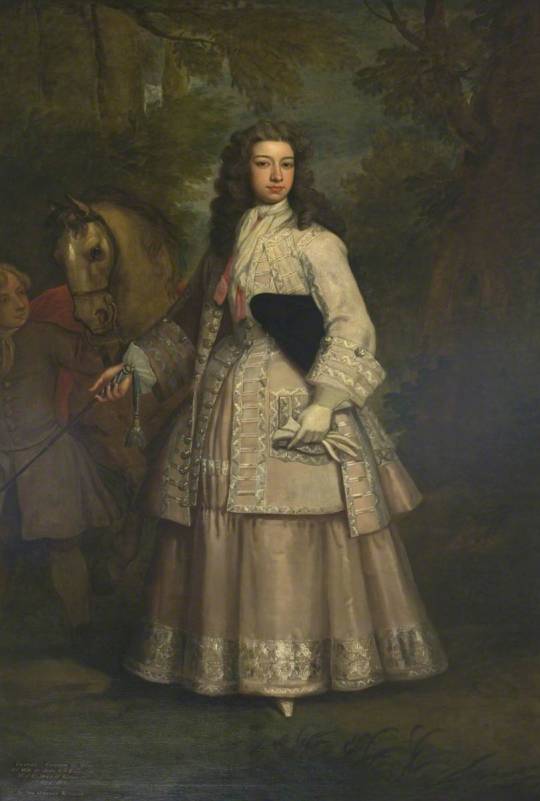
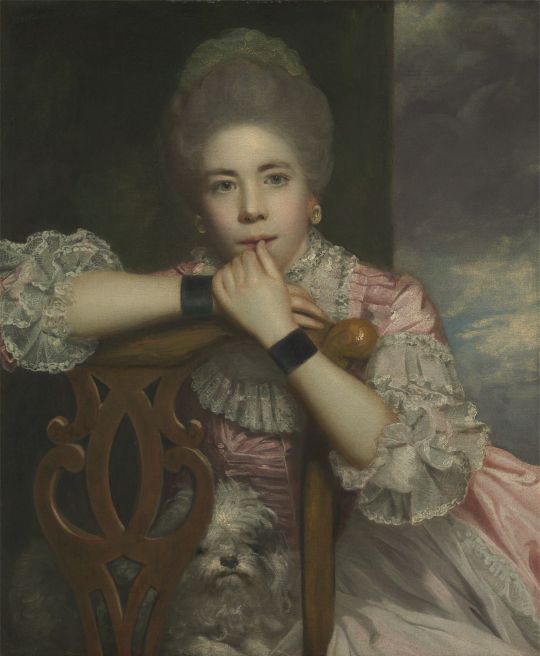
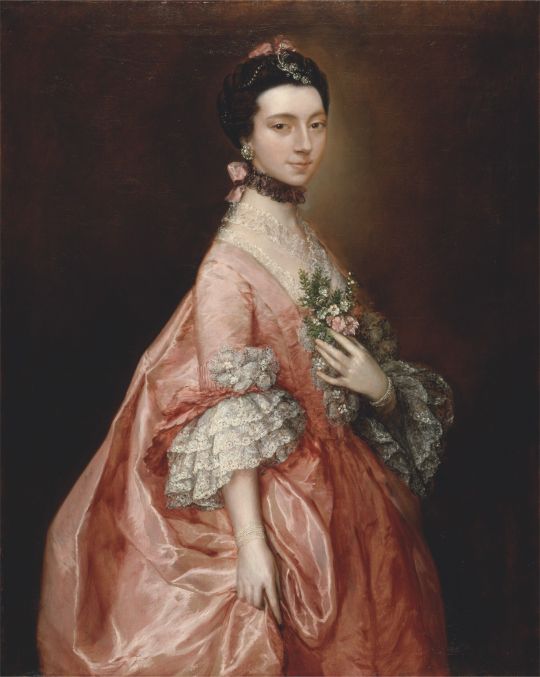
[Left: Frances, Daughter of Evelyn Pierpont, 1st Duke of Kingston, oil on canvas, c. 1700-23, by Godfrey Kneller, via Art UK.
Middle: Mrs. Abington as Miss Prue in "Love for Love" by William Congreve, oil on canvas, c. 1771, by Sir Joshua Reynolds, via Yale Center for British Art.
Right: Mary Little, later Lady Carr, oil on canvas, c. 1765, by Thomas Gainsborough, via Yale Center for British Art.]
In particular pink was popular amongst young women as the colour was associated with youth. Older women who wore pink were mocked as vain for dressing in a way that was seen as improper for their age. On the 31st of January 1754 Lady Jane Coke writes to Mrs. Eyre criticising old women who wear pink:
As for fashions in dress, which you sometimes inquire after, they are too various to describe. One thing is new, which is, there is not such a thing as a decent old woman left, everybody curls their hair, shews their neck, and wears pink, but your humble servant. People who have covered their heads for forty years now leave off their caps and think it becomes them, in short we try to out-do our patterns, the French, in every ridiculous vanity.
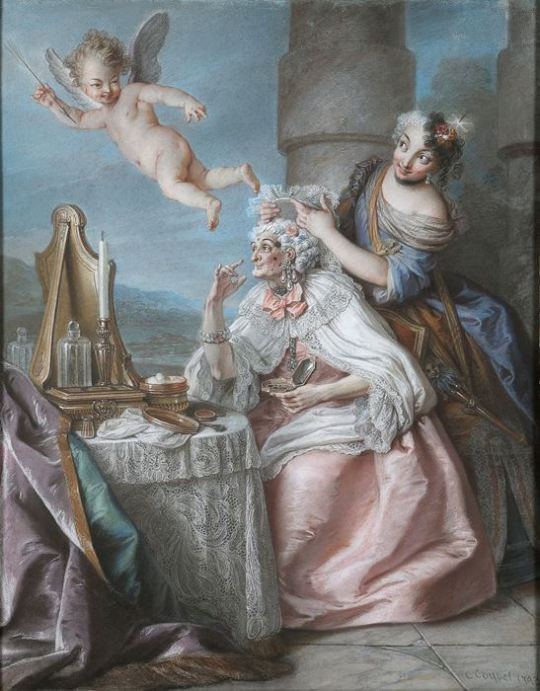
[Folly Embellishing Old Age With the Adornments of Youth, oil on canvas, c. 1743, by Charles-Antoine Coypel, via Master Art.]
For Englishmen acceptable clothing way much more limited. In A Foreign View of England in the Reigns of George I & George II Monsieur César de Saussure writes that Englishmen "do not trouble themselves about dress, but leave that to their womenfolk". He explains:
Englishmen are usually very plainly dressed, they scarcely ever wear gold on their clothes; they wear little coats called "frocks," without facings and without pleats, with a short cape above. Almost all wear small, round wigs, plain hats, and carry canes in their hands, but no swords. Their cloth and linen are of the best and finest. You will see rich merchants and gentlemen thus dressed, and sometimes even noblemen of high rank, especially in the morning, walking through the filthy and muddy streets.
César de Saussure warns that "a well-dressed person in the streets, especially if he is wearing a braided coat, a plume in his hat, or his hair tied in a bow, he will, without doubt, be called "French dog" twenty times perhaps before he reaches his destination" and is not only at risk of "being jeered at" but also "being bespattered with mud, but as likely as not dead dogs and cats will be thrown at him."
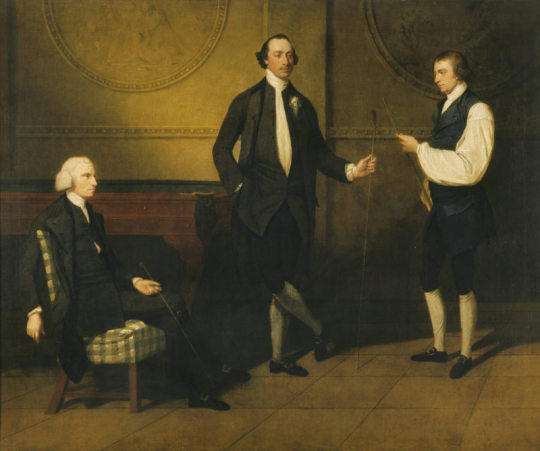
[Reverend Charles Everard Booth, Captain Griffith Booth, and an Unidentified Man playing Billiards, oil on canvas, c. 1775-9, by John Hamilton Mortimer, via the Royal Collection Trust.]
For Englishmen dressing "plainly" mostly meant wearing blacks and browns. In his book on macaroni, Pretty Gentleman, Peter McNeil found that in contrast most English menswear that he describes as generally consisting of "monochrome broadcloth" macaroni wore a variety of colours including green, orange, yellow, violet, red, white, blue, gold, silver and of course pink.
But it's not just the macaroni of the 1770s & 1780s that wore pink. We see pink in descriptions of feminine men's dress (both real and fictional) throughout the 18th century.
On the 2nd of June 1722 Sarah Osborn writes to Robert Byng:
I believe the gentlemen will wear petticoats very soon, for many of their coats were like our mantuas. Lord Essex had a silver tissue coat, and pink color lutestring waistcoat, and several had pink color and pale blue paduasoy coats, which looked prodigiously effeminate.
On the 18th of October 1729 the Universal Spectator and Weekly Journal published a story where an "effeminate" man's clothes were described as follows:
He had a flower'd pink-colour Silk Coat, with a Green-Sattin Waistcoat lac'd with Silver. Velvet Breeches, Clock'd Stockings the Colour of his Coat, Red-heel'd Pumps, a Blue Ribbon at the Collar of his Shirt, and his Sword-Hilt he embrac'd under the Elbow of his Left Arm,

[Sir Miles Stapylton, 4th Bt of Myton, oil on canvas, c. 1730-35, via Art UK.]
In The Adventures of Roderick Random (1748) the effeminate (and queer coded) Captain Whiffle is described as follows:
our new commander came on board in a ten-oared barge, overshadowed with a vast umbrella, and appeared in everything the reverse of Oakum, being a tall, thin young man, dressed in this manner: a white hat, garnished with a red feather, adorned his head, from whence his hair flowed upon his shoulders, in ringlets tied behind with a ribbon. His coat, consisting of pink-coloured silk, lined with white, by the elegance of the cut retired backward, as it were, to discover a white satin waistcoat embroidered with gold, unbuttoned at the upper part to display a brooch set with garnets, that glittered in the breast of his shirt, which was of the finest cambric, edged with right Mechlin: the knees of his crimson velvet breeches scarce descended so low as to meet his silk stockings, which rose without spot or wrinkle on his meagre legs, from shoes of blue Meroquin, studded with diamond buckles that flamed forth rivals to the sun! A steel-hilted sword, inlaid with gold, and decked with a knot of ribbon which fell down in a rich tassel, equipped his side; and an amber-headed cane hung dangling from his wrist. But the most remarkable parts of his furniture were, a mask on his face, and white gloves on his hands, which did not seem to be put on with an intention to be pulled off occasionally, but were fixed with a curious ring on the little finger of each hand.

[Henry Ingram, 7th Viscount Irwin and His Wife Anne, oil on canvas, c. 1745, by Philippe Mercier, via Art UK.]
On the 28th of July 1780 the London Courant reports:
A few days ago, a Macaroni made his appearance in the Assembly-room at Whitehaven, in the Following dress: a mixed silk coat, pink sattin waistcoat and breeches, covered with an elegant silver nett, white silk stockings with pink clocks, pink sattin shoes and large pearl buckles, a mushroom coloured stock, covered with a fine point lace; his hair dressed remarkably high, and stuck full of pearl pins.
On the 6th of August 1792 The Weekly Entertainer published Sketches and Portraits form the Life by Simon Tueopnrastus which included the following description:
Mercator was a youth of some genius and expectation, but by a strange perverseness of disposition, notwithstanding the extreme natural stiffness of his limbs, he had acquired an early attachment to the most finical and effeminate finery; so that, while yet a boy, he would exhaust every expedient of a fertile invention to procure a laced waistcoat, or the most foppish toy; would dangle a watch-string, with brass seals, from each fob, at a time when the frugal care of his parents would not permit him to wear a watch in either; and would strut in a fine pair of second-hand pink silk breeches, and a light blue coat, with all the formal dignity of—a soldier upon the parade.


[Left: Thomas King in "The Clandestine Marriage", oil on canvas, c. 1792, by Samuel De Wilde, via Yale Center for British Art.
Right: Edward Payne, oil on canvas, by Arthur Devis, via Art UK.]
While pink is mentioned in these descriptions of feminine men's dress it's not singled out as the girl colour the way pink would become in the 20th century. I would argue pink is seen as effeminate not because pink is a uniquely feminine colour but because it was used in fashionable dress. In 18th century England being interested in fashion was seen as an frivolous female trait. Men who showed too much interest in fashion were mocked and ridiculed for their gender nonconformity. "A Man must sink below the Dignity of his Nature, before he can suffer his Thoughts to be taken up on so trivial an Affair, as the Chosing, Suiting, and Adjusting the Adornments of his Person," complains a letter published on the 8th of May 1731 in Read's Weekly Journal, or British Gazetteer:
Decency of Garb ought inviolably to be preserved; nor can there be possibly an Excuse for Dressing like a Merry-Andrew: Rich and coloured Silks are in themselves effeminate, and unbecoming a Man; as are, in short, all Things that discover Dress to have been his Study 'Tis in vain for a Fop of Quality, to think his Title will protect him.


[Left: Madame de Pompadour (detail), oil on canvas, c. 1756, by François Boucher, via Alte Pinakothek.
Right: Elizabeth Wrottesley, later Duchess of Grafton, oil on canvas, c. 1764-5, by Thomas Gainsborough, via National Gallery of Victoria.]
English fashion was highly influenced by French fashion. A popular colour scheme in French fashion was green and pink. A famous example of this colour pairing can be seen in François Boucher's portrait of Madame de Pompadour (above left), she is depicted in a green gown with pink bows and flowers. You can see and example of how this style inspired English fashion in Thomas Gainsborough's portrait of Elizabeth Wrottesley (above right), who is depicted in a green gown with a floral pattern adorned with pink, white and green striped bows.
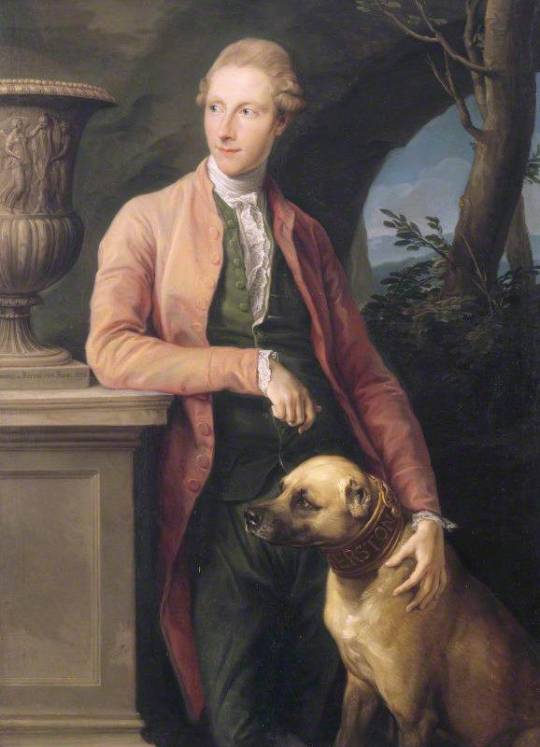
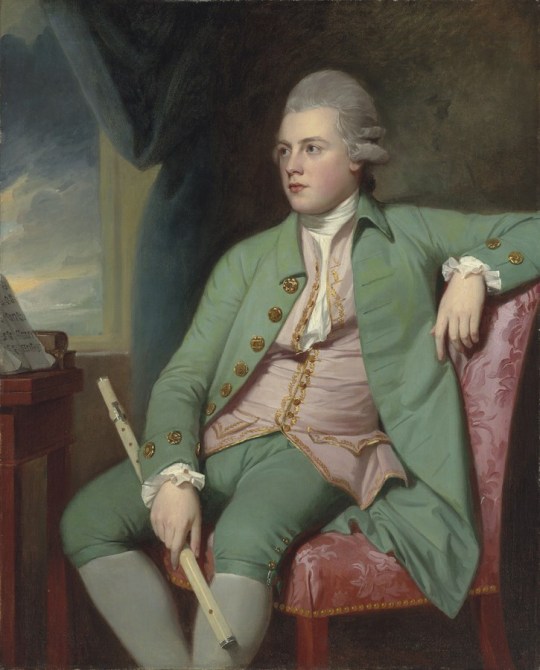
[Left: Sir Harry Fetherstonhaugh, oil on canvas, c. 1776, by Pompeo Batoni, via Wikimedia.
Right: Francis Lind, oil on canvas, c. 1775, by George Romney, via Mackinnon Fine Art.]
Fashionable Englishmen were also inspired by these French designs. Horace Walpole refers to the popularity of the colour combination writing to Lady Ossory on the 19th of February 1774 "If I went to Almack's and decked out my wrinkles in pink and green like Lord Harrington, I might still be in vogue". Almack's is referring to Almack's Assembly Rooms on Pall Mall which is believed to be the inspiration for the Macaroni Club. (see Pretty Gentleman by Petter McNeil p52-55) In a letter to Lord Harcourt on the 27th of July 1773 Walpole writes of "Macaronis lolling out of windows at Almack's like carpets to be dusted."
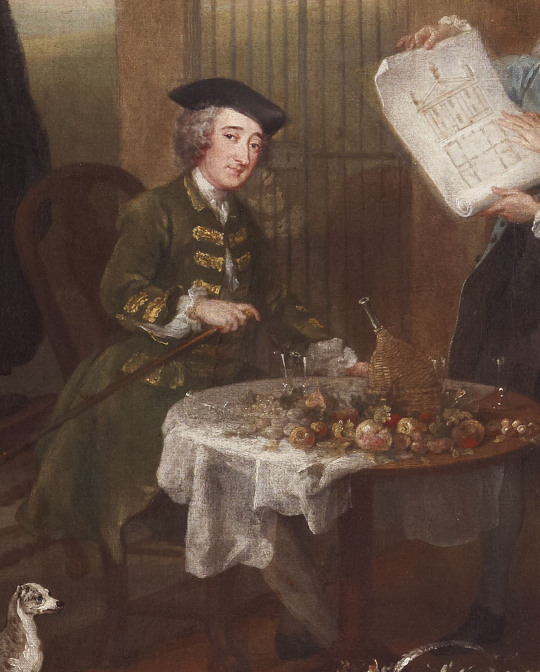

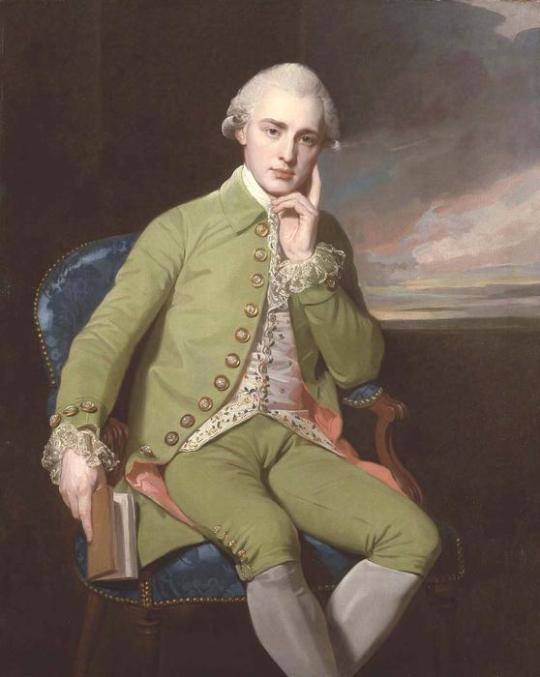
[Left: Detail of Stephen Fox from The Hervey Conversation Piece, oil on canvas, c. 1738-40, by William Hogarth, via Fairfax House.
Middle: Sir William Jones, oil on canvas, c. 1769, by Francis Cotes, via Art UK.
Right: Portrait of a Gentleman, oil on canvas, by George Romney.]
Men who wore green seem to have been just as much, if not more, at risk of being ridiculed, or even assaulted, for the colour of their clothes as those who wore pink. In Pierre Jean Grosley's A Tour to London (originally published 1772) he recalls traveling with a young English surgeon who was harassed by Londoners due to his green French frock coat:
At the first visit which he paid me in London, he informed me, that, a few days after his arrival, happening to take a walk thro' the fields on the Surry side of the Thames, dressed in a little green frock, which he had brought from Paris, he was attacked by three of those gentlemen of the mobility, who, taking him for a Frenchman, not only abused him with the foulest language, but gave him two or three slaps on the face: "Luckily, added he in French, I did not return their ill language; for, if I had, they would certainly have thrown me into the Thames, as they assured me they would, as soon as they perceived I was an Englishman, if I ever happened to come in their way again, in my Paris dress."
231 notes
·
View notes
Note
What if… Sam had a sibling who is very chaotic!!!! And they survive through out the Bayverse movies and when they meet Hound, Crosshairs and Drift, how would those 3 react to the crazy lil human?!? ;-;
(Could you possibly add Optimus Prime and Bumblebee!?)
Okay this is the first ever request I answer, kinda nervous tbh.
Hope you like it, and thanks for requesting^^
It's called Haiku...

Also, I don't know what pictures to add lmao
About this fic: sfw, gn reader, takes place in aoe
901 words
Sitting in the passenger's seat, squished next to Shane, you look out the window.
Sure, it was uncomfortable, but there were only 3 seats for the 4 of you.
You didn't say anything though, after they had just lost their friend, complaining would be of no use.
So you watch the wide desert landscape going by.
A white truck drove by on the other side of the road, but you didn't pay that much attention to it.
That's when the truck you four were in started rumbling. At first you didn't know what was going on, but when the seats shifted back roughly, the worn down leather replaced by more comfortable fabric seats you kind of got an idea.
"A man of taste I see. Western Stars are pretty nice.", you complimented, after seeing the symbol on the steering wheel, before the autobot logo took its place.
You opened the window to take a look at the Prime's new altmode.
Red flames across the blue paintjob, and everything was just so shiny.
"I must say, you looking good Prime!", you laugh, sticking your head back in.
"It was awesome but it was insane!", you heard Shane yell out excitedly.
The Prime's deep voice echoed over the radio, calling for his Autobots.
"I wonder If I'll see Bumblebee again. I missed that guy."
"Bumblebee?", Cade asked.
"Yeah, he's an Autobot don't worry. He's no giant insect, if that's what you thought about."
The man just raised an eyebrow at you, making Tessa chuckle in amusement.
After a few more minutes of driving you all got out of the truck, after Optimus opened the doors for you.
"Your dad is nice, but he needs to relax a lil...", you whisper to Tessa.
"He sure does, but he's trying his best."
"Never doubted that, don't worry.", you add, nudging her arm gently.
Optimus transformed, being greeted by his bots.
"Mr. free leader of the galaxy. I knew you'd make it. I never doubted it."
"Just who are these guys...", you mumble, looking around.
The green one with what looks like a cape suddenly turned to point his guns at you.
"Oh okay, that one feels like killin today...", you say, raising you arms sarcastically.
When the biggest one started lifting his guns was when you started sweating though.
But having fate on your side, like always, Optimus stopped them.
"Thanks Prime, I thought I was done for this time."
"🎶...Survivor! 🎶", Bee's Radio echoed.
"What's he mean by that now?", Hound asked, adjusting his cigar.
"We go way back. I saw Megatron so many times already. He nearly killed me twice but meh, still alive and kicking"
"Wait, aren't you that human from the fight in-?", Drift turned to ask.
"Chicago? Yeah, I've been there. Threw a brick at Megs myself.", you interrupted, proud of your past actions, arms crossed before your chest. "I've been there since the beginning. When it was just about a pair of glasses from my crazy great grandfather."
"They have fought with us. They're the only human I know I can trust."
"Rude...", Shane mumbled under his breath.
"I mean, how'd a squishy survive all that?!", Hound asked into the round of Cybertronians and humans
"Who you callin squishy?! I'm not the big one here."
"Pff, that's just armor. I'm as fast as a horse!"
"Well first of, it's as healthy as a horse. And also, it's none of your damn business how I survived all the shit I've been through. Because honestly, I don't even know myself. Maybe I'm just lucky"
You shrug, looking up at Optimus, who's serious demeanor made your heart sink.
He's always been serious yes, but a kind soul. Always open for questions.
Now he's just, well... dark.
"Well, but I'm sure as hell gonna survive this, so when we startin?!"
"Enthusiasm, I like it.", Crosshairs mentioned, spinning a gun in his servo, before tucking in back into his belt.
"🎶Where have youuuu been?!🎶", Bumblebee sang over the radio.
"Oooh, Rihanna, you got some mad taste Bee!"
Sticking your hands into the pockets of your worn down jeans, you look up at the yellow and black bot, who's optics were fixed on you.
"Well, after Chicago I needed a new place to stay. So I applied to work in a different hospital. And it led me to Austin, Texas."
You laugh
"In the good ol' south", you say, mocking the southern accent.
"I think I like that one", Hound says, leaning back against a rock wall.
"They have what it takes, like sunset colors on blue,
strength guts and virtue.", Drift added.
"If this is another hiku I swear Imma blow you to shreds...", Crosshairs murmured, turning to walk away.
"It's called Haiku!", you correct him.
"What?", he mumbled annoyed.
"I don't care what it's called. I just want to leave this place."
"Well, I like it, thank you.", you say to Drift, smiling at the bot.
In this moment of peace, it was of course Crosshairs who needed to add something unnecessary.
"Nah, it's lame"
Without warning, Drift jumped at him, swords drawn, ready to attack.
"And I thought I was crazy...", you whisper to Bee, rolling your eyes.
The bot snickered.
"Lord may you give me strength to not make anyone here short circuit on purpose..."
You squint your eyes, thinking.
"I don't even know their names yet... Wow"
"🎶Still don't know your name🎶"
"Oh you're right tho Bee.", you laugh
#transformers x reader#request#bayverse drift#bayverse crosshairs#bumblebee#optimus prime#Bayverse Hound
139 notes
·
View notes
Text
Indeed, William Shakespeare was the Western World's first femboy bottom in history, much like another forthward thinker of his time: Benjamin Franklin, often considered the world's first Discord Daddy and a major influence in the spread of hentai in the colonies; however, like all great Western inventions, such as tea, noodles, the printing press, and Chicago, these innovations had been done centuries earlier, by the Chinese.
186 notes
·
View notes
Photo

Chicago Great Western S1 #13 at the road's terminal in Oelwein, Iowa, circa 1965.
44 notes
·
View notes
Photo

CGW 858 at Beverly, MO
August 12, 1936
1 note
·
View note
Note
Saw this on Reddit, could this be a coydog? https://www.reddit.com/r/animalid/comments/105o3g4/local_residents_page_in_mi_cant_decide_if_this_is/?utm_source=share&utm_medium=ios_app&utm_name=iossmf
I don’t know much about them as I don’t have coyotes in my country but I love learning form your account and seeing the massage variation in them, thank you for posting
So here's the picture of the coyote in question:

And images of the subspecies in that area, Canis latrans thamnos:


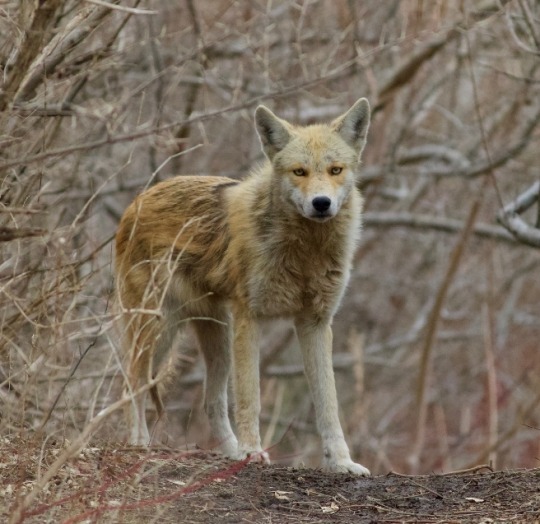


The Great Lakes/Northeastern coyotes are one of my favorite subspecies. They have a very unique skull shape and build since they're in this transitional space between the western subspecies and the Eastern Coyote (Canis latrans "var.").
Red coyotes are a very common morph among Eastern coyote subspecies. You see them in almost every Eastern state, and especially within the Northeastern subspecies. Though the theory is that this coloration was introduced into coyote population from dogs, many Northeasterns seem to be this color because it's just beneficial to the environment they live in. I'd need to find the image but there's a trial cam photo of a Northeastern coyote in the woods up there and it blends almost perfectly into the landscape. Coyotes are known for being incredibly adaptable and, as we've seen in Eastern Coyotes, if it's an adaptation they benefit from in a particular area, it spreads realtivly quickly through the populations. I've also wondered if because they look very dog-like from a distance is why you see a lot of them in urban environments (little bit of urban camouflage because the average person would see that color and think they're dogs, so they're left alone and can spread those genes). Here's a group of red Northeastern ones living in downtown Chicago:

There's nothing about the image of that coyote to make me think it's a high content coydog. Read through a lot of the comments on reddit and all these "dog traits" people are looking at are just traits common within that subspecies. I haven't seen a ton of studies done on the Northeastern subspecies but the Eastern Coyotes which are more know for hybridization are still predominantly coyote with admixtures of dog, gray wolf, and eastern wolf within thier lineage. Basically, unless the animal is captured and tested, it's a safer bet to consider it a coyote until proven otherwise.
There was a black coyote that caused a big scene several years ago who was seen actively playing with and befriending dogs. The public was convinced he was a coydog because of his coloration and behavior. He was eventually captured and taken to a conservation center and samples from him were sent to UC Davis. No recent dog lineage was found. He was just a black coyote. His name's Carmine and he's adorable btw
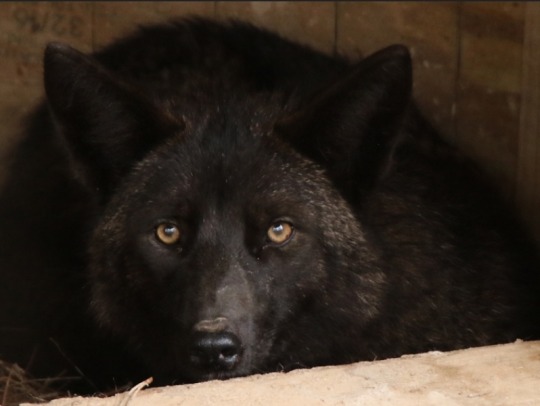
There's also this little lad who was tested and is confirmed to be an F1 coydog. From a distance he would look like a typical coyote, but he's half border collie.

Morphology alone is not the best indicatator for whether or not coyotes have high content of dog or wolf in them, especially if you aren't aware of the differences between the subspecies. Genetic testing is the only way to 100% confirm whether they do or not. Just from that one pic and knowing what area the coyote is from, I definitely think it's a just Northeastern coyote.
#coyote#color morph#I've worked on a lot of Northeastern coyotes#and they deffo have some funky traits and colors#but a coyote can be 99% coyote and look very wolfy or doggy#while an F1 hybrid can look just like a normal coyote#I have my own rubric and markers I look for when I work on yotes#if I notice anything sus I write it down as 'may have recent dog or wolf lineage TBT'#but until I can get those samples tested I can't say for certain#unless it's like#blatantly obvious which has only been a couple cases#ask
658 notes
·
View notes
Text
What-If: American Railroads — Section 2: Railroads Absorbed (part 2)


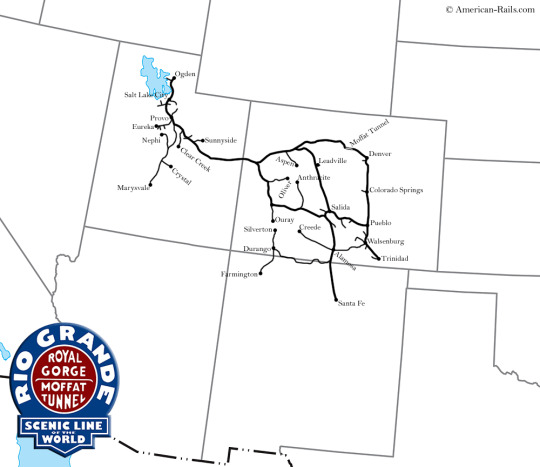
F. Union Pacific ⬆️
Western Pacific
Rio Grande

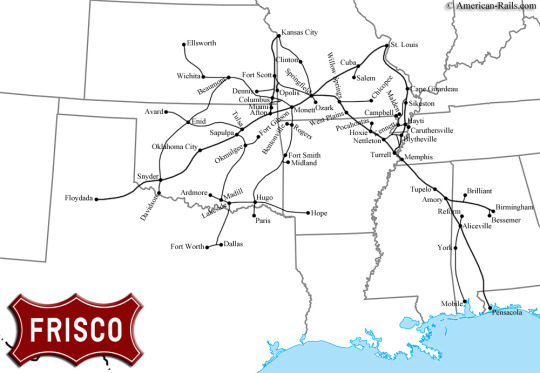

G. Missouri Pacific ⬆️
Frisco
Texas and Pacific
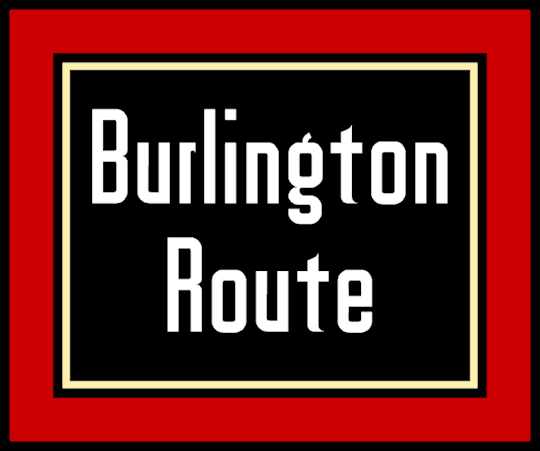

H. Burlington Route ⬆️
Kansas City Southern

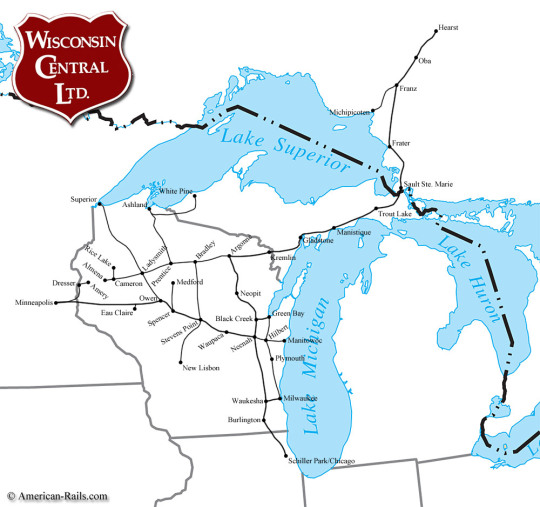

I. Chicago and Northwestern ⬆️
Wisconsin Central
Minneapolis and St. Louis Railway


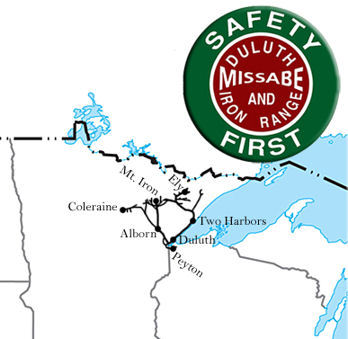
J. Northern Pacific ⬆️
Chicago Great Western
Duluth, Missabe and Iron Range

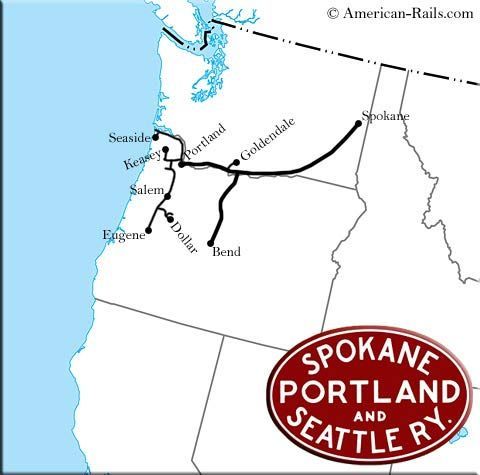
K. Great Northern ⬆️
Spokane, Portland and Seattle
#history#railroad#railroads#railway#railways#union pacific#missouri pacific#burlington route#chicago & north western#northern pacific#great northern#alternate history
2 notes
·
View notes
Text
Sun Wukong's Buddhist Paradise
Some of my followers may be familiar with my past article in which I described Xuanzang's historical itinerary and discussed what a more realistic Journey to the West might be like. Towards the end, after the pilgrims return to China with the scriptures and the disciples (Sun Wukong, Zhu Bajie, and Sha Wujing) receive their elevation in spiritual rank, I stated: “They would thereafter leave to enjoy their divine lives in the Western Paradise.” But I’ve never really liked the idea that Monkey would forever abandon his people. This is especially true since his rebellion led to heaven decimating the monkeys and burning their cave (Wu & Yu, 2012, vol. 2, p. 31).
I think a better ending for this historical version would be for the “Victorious Fighting Buddha” to return to the Mountain of Flower and Fruit, where he transforms it into his own Pure Land (Jingtu, 淨土). The monkeys killed in years passed would be reborn there, and everyone would receive periodic lessons on the dharma between bouts of play. It would be a paradise even grander than when the Great Sage was at the height of his power.
Here is some information about pure lands from the Encyclopedia of Buddhism (Gomez, 2004):



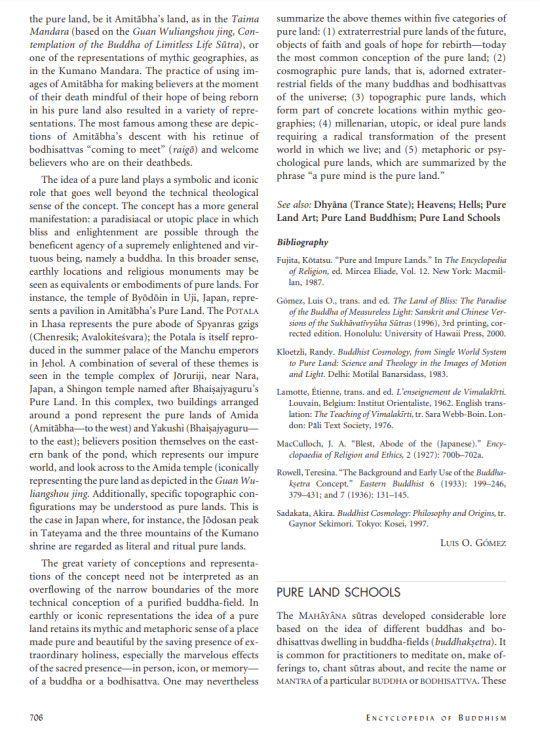
I love this circa 1700 Tibetan painting of Amitabha in his pure land of Sukhavati. Just imagine the Victorious Fighting Buddha sitting in Amitabha's place, and monkeys would take the place of the monks, protectors, and devas.

Sources:
Gomez, O. L. (2004). Pure Lands. In R. E. Buswell (Ed.), Encyclopedia of Buddhism (pp. 703-706) (Vols. 2). United Kingdom: Macmillan Reference, USA.
Wu, C., & Yu, A. C. (2012). The Journey to the West (Vols. 1-4). Chicago, Illinois: University of Chicago Press.
#sun wukong#monkey king#journey to the west#buddhism#Pure land#amitabha#Victorious Fighting Buddha#Buddha Victorious in Strife#Lego Monkie Kid#LMK#JTTW#dharma
79 notes
·
View notes